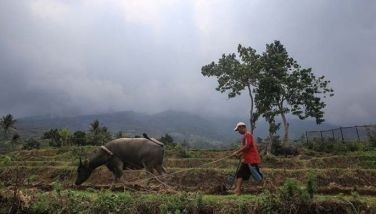Nazarene to draw 15 M
MANILA, Philippines – It will be a record mammoth crowd: as many as 15 million people are expected to participate in today’s procession of the Black Nazarene from the Quirino Grandstand to Quiapo Church in Manila, organizers said yesterday.
According to the situational report released by the Minor Basilica of the Black Nazarene, the attendance today would surpass the crowd size during the past five years or since 2011.
It said that from 2011 to 2015, about six million to 12 million people attended the event from Jan. 7 to 9, with an annual growth rate of 20 percent.
For this year, organizers are projecting the number to swell to 13 million to 15 million, as people gather along the procession route from Rizal Park to Quiapo.
“This is mainly due to the fact that this year’s celebration falls on a weekend. The growing number of fiesta devotees will add up to the regular Friday and Sunday devotees. Another factor is the declaration of the city government of Manila making Quiapo Fiesta 2016 as an international pilgrimage event,” the report said.
This year would be the 410th anniversary of the Feast of the Black Nazarene.
The religious event is celebrated every year in Quiapo during the first two weeks of January. It starts with a thanksgiving procession at dawn of Dec. 31, a Marian procession in the afternoon of Jan. 1, a replica procession on Jan. 7, the “Pahalik” or kissing of the Black Nazarene on Jan. 8 and the traslacion procession on Jan. 9.
The usual novena masses and continuous fiesta masses are held in Quiapo Church.
In preparing for the event, organizers came out with a list of “dos and don’ts.”
It reminded the mamamasans (devotees) to behave accordingly and show respect for the altar at the Quirino Grandstand and at Quiapo Church, which are regarded as “holy ground” where masses are held.
In previous years, the send-off and the traslacion have been chaotic, with the mamamasans climbing over security railings and going up the stage even before the mass ended.
They try to beat each other to the image of the Black Nazarene and bring it to the metal carriage called the andas, which would be waiting on the left side of the stage.
The organizers also reminded the mamamasans that they should be calm and humble, show respect to others and avoid wearing sharp objects that could injure their fellow devotees.
For first timers, they should seek advice and guidance from senior devotees on the proper way of holding the rope and how to avoid accidents.
The devotees should not drink alcohol before joining the procession.
For the rest of the devotees, the organizers said that those pregnant or persons with disabilities should not attend the traslacion. They should also refrain from bringing their children close to the procession. They should also not wear any jewelry and not bring or use firecrackers.
They should also avoid narrow places and not position themselves close to the walls because they could be pinned when the crowd passes. They should not position themselves along the procession route.
Devotees are also prohibited from bringing selfie sticks.
Church officials said the Feast of the Black Nazarene should not be treated as a “trending topic” but a religious event.
As for vendors, they were advised to bring empty sacks to collect garbage along the procession route and to make sure that their surroundings are clean.
Nicolasito Salimbagat Jr., the procession marshal, gave assurance that the rope and andas to be used are ready for the difficult task ahead.
The rope, about 10 meters long and five centimeters in width, is made of abaca. They made it a point not to use new ropes because these are not flexible and could injure the mamamasans. The ropes are immersed in water to make them more pliant.
“Sometimes the rope will last for two to four years before it is replaced. But sometimes it does not even last for three years because when the image of the Black Nazarene arrives at Plaza Miranda, some of the devotees pluck out strands from the rope to put it on their altar. For them it is a symbol of their faith,” Salimbagat said.
The andas is made of metal and will still move even if there are 30 to 40 people atop the carriage. There are also two people underneath the andas holding on to a lever controlling the brakes.
Salimbagat said the two front wheels of the carriage are made of solid rubber and can turn in any direction.
The two men under the carriage also make sure they avoid trampling over the barefoot devotees.
As part of the preparation, the andas undergoes routine checkup at Sarao Motors and a technical team keeps it in top shape for the traslacion.
Authorities have deployed thousands of policemen and medical personnel along the procession route, which is the same as last year.
The Black Nazarene is a life-size image of Jesus clad in a maroon robe, wearing a crown of thorns and carrying a big wooden cross in a semi-kneeling position.
The image, which has survived earthquakes, fires, bombings and floods, is believed to be miraculous.
Many devotees brave the huge crowds to attend the traslacion to ask forgiveness for their sins, to ask favors as well as give thanks for favors or pleas granted. – Jose Rodel Clapano, Ghio Ong
- Latest
- Trending
































